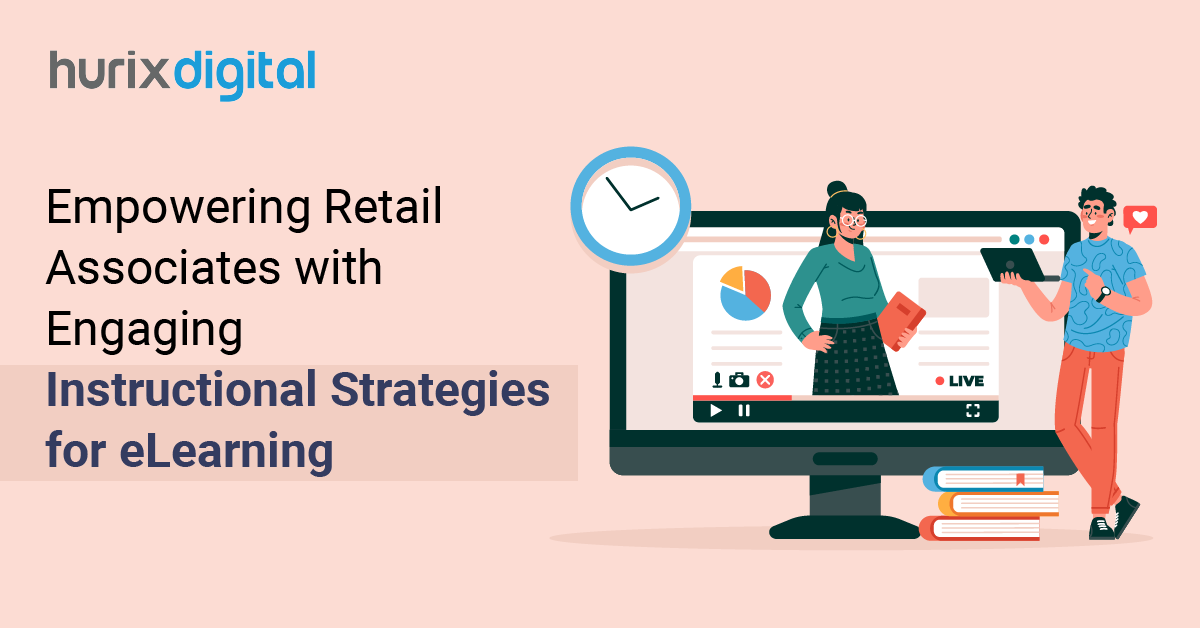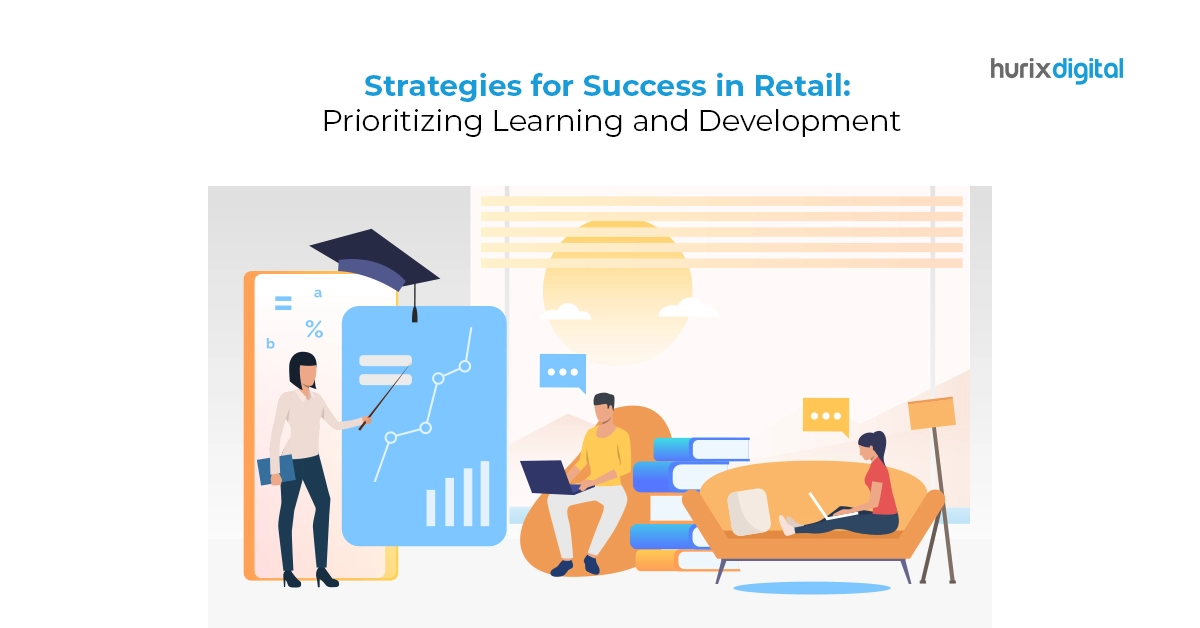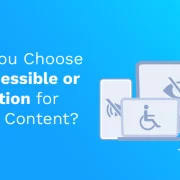
Empowering Retail Associates with Engaging Instructional Strategies for eLearning
Summary
Explore how retail stores increase sales by leveraging eLearning, employing ADDIE and SAM models, and forming remote teams for custom skill-enhancing courses.
As customer needs grow and markets change, retail stores must have well-equipped staff. A recent research study found that highly trained employees could potentially boost sales by half per employee.
This is where eLearning comes into play; it offers a means to provide training for your team. Conventional training methods often struggle to keep up with the fast-paced industry evolution.
Nevertheless, it’s worth noting that not all instructional strategies for eLearning programs are equal. To truly understand the needs and experiences of your staff, it’s crucial to create learning experiences. By integrating methods into your training programs, you can transform them into resources that enhance employee effectiveness and promote business expansion.
Table of Contents:
- Instructional Design Trends for Engaging eLearning Outcomes
- Instructional Design Models for Effective eLearning
- Choosing the Right Model
- Remote Instructional Design: Building Effective eLearning Teams
- Conclusion
Instructional Design Trends for Engaging eLearning Outcomes
The landscape of remote instructional design is constantly evolving, offering exciting new ways to create immersive and engaging eLearning experiences. Here are some key trends to consider:
1. Microlearning for Bite-Sized Knowledge
Shorter doesn’t mean less effective- Microlearning delivers focused, bite-sized learning modules that cater to busy schedules and improve knowledge retention.
- Break down complex topics into smaller, manageable units.
- Provide short learning modules focusing on skills or product information.
- Ensure they can be finished in small sessions, such as five to 10 minutes each.
2. Gamification: Adding Fun to the Learning Journey
Gamification incorporates game mechanics into eLearning experiences. This makes learning interactive, stimulates competition, and motivates learners.
- Implement points, badges, and leaderboards to encourage participation.
- Design interactive scenarios and simulations to practice real-world skills.
- Offer rewards for completing modules or achieving milestones.
3. Mobile-First Design for On-the-Go Learning
People often seek information while on the move. Make sure your online learning materials are tailored for use on the go.
- Create designs that adjust and adapt to screen dimensions.
- Offer downloadable modules for offline access.
- Incorporate short video snippets and interactive elements.
4. Interactive Video for Enhanced Engagement
Videos are a powerful learning tool. Utilize interactive video elements to boost learner engagement.
- Include quizzes, polls, and branching scenarios within videos.
- Integrate hotspots for learners to explore additional information.
- Caption your videos to cater to diverse learners and accessibility needs.
5. AI-Powered Personalization for Tailored Learning
Effective learning relies on personalization. AI can provide learning experiences that cater to needs.
- Utilize intelligence to customize learning paths according to learners’ areas of knowledge that need improvement.
- Offer adaptive quizzes that adjust difficulty levels based on performance.
- Integrate chatbots for tailored assistance in learning.
Also Read: 8 Challenges and Solutions in Localizing Training Programs for a Diverse Workforce
Instructional Design Models for Effective eLearning
Instructional strategies for eLearning frameworks offer an approach to developing eLearning content. By following these models, you can create crafted courses that captivate learners and meet goals effectively.
Selecting the design framework is essential in developing impactful eLearning initiatives. Today, let us look at two widely utilized models: ADDIE and SAM.
1. ADDIE Model: A Structured Approach
ADDIE is a systematic, linear model widely used in instructional design. It stands for:
- Analysis: Identifying training needs, target audience, and learning objectives.
- Design: Developing learning objectives, content outlines, assessments, and instructional strategies.
- Development: Creating eLearning materials, such as videos, simulations, and interactive elements.
- Implementation: Delivering the training to learners and providing support.
- Evaluation: Assessing the effectiveness of the training program and making improvements.
| Advantages | Disadvantages |
| Provides a structured approach for planning and development | Can be time-consuming and rigid |
| Ensures thorough analysis and design before development | Less adaptable to changes in project requirements |
| Offers a clear framework for evaluation |
2. SAM Model: Agile Development for Faster eLearning
The Successive Approximation Model (SAM) is a more flexible and iterative approach to instructional strategies for eLearning. It consists of three phases:
- Preparation: Defining project goals, identifying stakeholders, and analyzing initial needs.
- Iterative Design: Creating prototypes or early versions of the eLearning content and gathering feedback.
- Iterative Development: Refine the content based on feedback and develop the final product.
| Advantages | Disadvantages |
|---|---|
| Faster development time due to iterative process | Requires experienced instructional designers |
| Adaptable to changes in project requirements | Less adaptable to changes in project requirements |
| Encourages collaboration and feedback | May lack the structure and rigor of the ADDIE model |
Choosing the Right Model
When choosing the evaluation model for design, it’s crucial to consider aspects such as the project’s size, timeline, finances, and the existing company culture. These factors should influence your decision-making process-
- Project Complexity: For complex projects with well-defined requirements, ADDIE might be suitable. For projects with uncertain requirements, SAM offers more flexibility.
- Time Constraints: SAM is generally faster than ADDIE, making it ideal for projects with tight deadlines.
- Organizational Culture: If your organization values a structured approach, ADDIE might be a better fit. SAM could be more effective if your organization prefers a more agile approach.
By grasping the advantages and limitations of design frameworks, you can choose the optimal instructional strategies for eLearning endeavors and develop captivating and successful learning opportunities for your retail staff.
Remote Instructional Design: Building Effective eLearning Teams
The surge of work has greatly influenced the operations of design teams. Creating an efficient instructional design team necessitates thoughtful preparation and successful tactics.
Challenges of Remote Instructional Design Teams
| Challenge | Description |
| Communication Barriers | Lack of face-to-face interaction can hinder effective communication and collaboration. |
| Time Zone Differences | Coordinating meetings and project timelines across different time zones can be challenging. |
| Isolation | Remote team members may feel isolated and disconnected from the team. |
| Tool Proficiency | Ensuring everyone is proficient in using collaboration and project management tools is essential. |
Building a High-Performing Remote Instructional Design Team
| Strategy | Description |
| Effective Communication Channels | Establish multiple communication channels (email, instant messaging, video conferencing) to suit different needs. |
| Regular Check-ins | Make sure to set up team gatherings and individual catch-ups to uphold communication and establish a good relationship. |
| Project Management Tools | Make sure to use project management software to monitor the advancement exchange files and work together effectively. |
| Virtual Collaboration Tools | Utilize whiteboards, share screens, and use document editing tools to enhance team collaboration. |
| Establishing a Strong Team Culture | Create a sense of community through virtual team-building activities and regular social interactions. |
| Continuous Learning and Development | Give team members chances to acquire skills and keep abreast of the instructional design trends. |
Also Read: How Flexible Staffing Future-Proofs Your Workforce Planning?
Conclusion
Creating eLearning content and teaching methods involves more than developing courses and modules. It’s important to offer opportunities for team members to acquire skills and stay informed about instructional design trends. It’s also about creating experiences that improve knowledge retention and ultimately drive a business’s growth.
Hurix Digital is well known for its expertise in eLearning solutions. Contact us to learn how to use different instructional strategies for improved eLearning experiences.

A highly enthusiastic and motivated sales professional with over twenty five years of experience in solution selling of training-related applications and services. Maintains an assertive and dynamic style that generates results. Ability to establish long-term relationships with clients built on trust, quality of service and strategic vision. Specializes in financial services, higher ed, publishing and government in the areas of learning and development.







